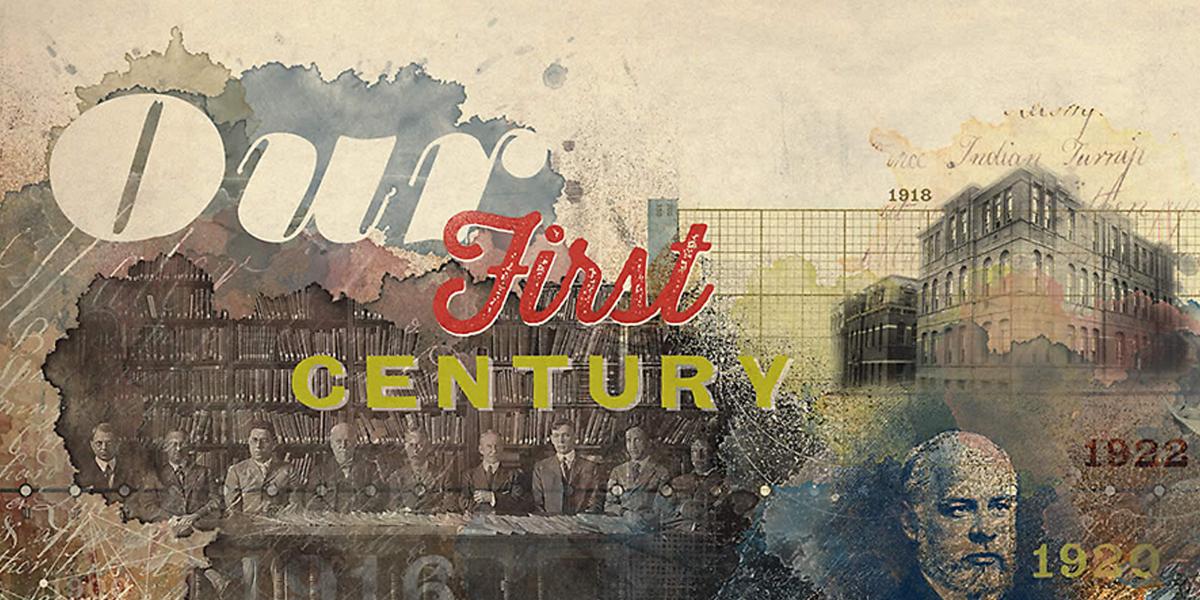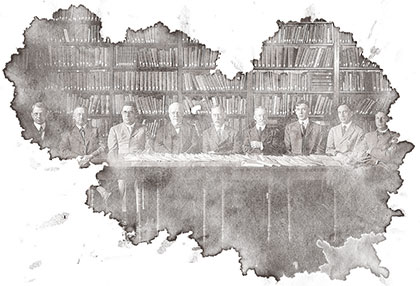Our First Century
From its June 13, 1916, birth as the world's first independent degree-granting school of public health, the Bloomberg School has made history with trailblazing research, education, and practice.
Here's a "first" look at the Centennial.
-
1916
Johns Hopkins University receives $267,000 from the Rockefeller Foundation and founds the Johns Hopkins School of Hygiene and Public Health, with William Henry Welch as its first director.
-
1917
William Henry Howell is appointed the first faculty member and becomes founding chair of the Department of Physiological Hygiene.
-
1917-18
First academic departments in the world are established in immunology, epidemiology and public health administration. JHSPH becomes the first school of public health to establish departments of statistics, bacteriology, chemical hygiene (biochemistry) and sanitary engineering.
-
1918
The first classes are held on October 1, 1918, in a physics lab on West Monument Street. Six of 16 students are female. Three are foreign citizens (from Brazil and Trinidad). Among 32 faculty, 9 are female.
-
1919
JHSPH awards three DrPH degrees to the School’s first graduating class. The first graduate is Nathan Berman.
-
1920
Margaret Baxter MacDonald and Helen Mary Powell are the first women to graduate from the School.
The certificate in Public Health (CPH) degree is established (renamed the Master of Public Health in 1939).
William Henry Welch founds the American Journal of Hygiene (now the American Journal of Epidemiology), the first public health research journal.
-
1922
Elmer V. McCollum, chair of Biochemistry, discovers vitamin D and its role in preventing rickets.
-
1926
The School’s first building on Wolfe Street formally opens on October 22, 1926.
-
1928
JHSPH receives its first major corporate grant ($195,000) from the Chemical Foundation to establish the John J. Abel Fund for Research on the Common Cold.
-
1930
After Lowell J. Reed is appointed chair of Vital Statistics, he renames it the Department of Biostatistics—the first of its kind worldwide.
-
1934
Margaret Gene Arnstein is the first nurse to graduate from JHSPH.
-
1935
Congress provides federal funding for public health under the Social Security Act. It provides training for public health professionals; CPH enrollment doubles as a result.
-
1936
The U.S. Public Health Service (USPHS) awards the first federal public health training grant to JHSPH, $10,000 annually for a graduate program in syphilis control.
-
1938
Raymond Pearl publishes evidence in Science that life expectancy correlates inversely with smoking levels.
-
1939
The School begins offering the Master of Public Health degree.
-
1941
The first academic unit devoted to preventing mental illness at the population level is launched. The mental hygiene division becomes a department in 1961.
-
1942
After developing the first effective pertussis vaccine, alumna Pearl Kendrick, ScD ’32, and Grace Eldering combine three key childhood vaccines into a single shot: the DPT vaccine.
The first research institute is established at JHSPH: the Center for Research on Poliomyelitis and Virus Diseases. Howard Howe, David Bodian, and Isabel Morgan investigate the pathology of polio, contributing toward Jonas Salk's vaccine.
-
1946
Public Health Service officer and Rockefeller Foundation fellow Reginald G. James, MPH ’46, becomes Johns Hopkins University’s first African-American graduate.
-
1947
Fred L. Soper, ScD ’25, leads the first successful mosquito eradication campaign in Brazil, championing DDT use in vector control of insect-borne diseases.
-
1949
Bodian and Morgan show there are three immunological types of poliovirus, revealing why previous vaccines failed.
Alexander Langmuir, MPH ’40, establishes the CDC’s epidemiology section, renamed the Epidemic Intelligence Service in 1951, to protect against biological warfare and manmade epidemics.
-
1950
The first department of environmental medicine is founded at the School.
-
1955
Frederik B. Bang, chair of the Department of Pathobiology, initiates research on viruses as cancer agents and introduces courses on electron microscopy. With George O. Gey, Bang develops effective tissue culture methods—a foundation for in vitro research.
-
1957
Margaret Merrell, ScD ’30, is appointed the School’s first female full professor.
-
1958
The School begins receiving federal tuition subsidies under the Hill-Rhodes Public Health Training Act, championed by Dean Ernest Stebbins.
-
1959
Helen Abbey, ScD ’51, co-authors one of the first studies of heredity in breast cancer.
Surgeon General Leroy Burney, ScM ’32, along with Morton L. Levin, MPH ’33, Abraham Lilienfeld, MPH ’49, and Lewis C. Robbins, MPH ’38, draft the first surgeon general’s report on Smoking and Lung Cancer.
-
1961
With a grant from USAID, the School establishes the first academic unit in international health. It is directed by Carl E. Taylor and becomes a department in 1967.
-
1962
JHSPH establishes PhD programs in biochemistry, biostatistics, environmental medicine and radiological science.
JHSPH launches the General Preventive Medicine Residency, the first board-certified graduate medical training program at a school of public health.
-
1965
JHSPH awards its first PhD to Clyde Martin, Alfred Kinsey's co-author on landmark sexuality studies.
-
1973
John E. Wennberg, MD, MPH ’66, and Biostatistics faculty member Alan Gittelsohn, PhD, MPH, write in Science about regional variations in cost and utilization of medical care, profoundly impacting our understanding of how medical decisions are made and paving the way to major reforms in the delivery and financing of health care.
-
1974
Susan P. Baker, MPH ’68, develops the Injury Severity Score, the first method to simply assess the likelihood of a fatality, given various combinations of injuries.
Johns Hopkins establishes the first pre-professional public health undergraduate major as a joint Hygiene-Homewood program.
Alan M. Goldberg, John Fales and postdoctoral fellow Ellen K. Silbergeld publish the first studies linking low-level exposure to lead with hyperactivity and other childhood disorders.
-
1979
Bernice Cohen, MPH ’59, establishes the nation’s first graduate program in genetic epidemiology.
-
1980
After a decade-long global campaign led by D.A. Henderson, MD, MPH ’60, WHO declares smallpox eradicated worldwide. Henderson serves as dean from 1977 to 1990.
-
1981
Women comprise a majority of the School’s graduates for the first time.
-
1985
Noel R. Rose edits the first textbook on autoimmune disease.
-
1986
Prior to becoming dean in 1990, Alfred Sommer, MD, MHS ’73, discovers the link between vitamin A deficiency and child mortality, establishing an inexpensive means of saving millions of lives.
-
1989
As founding director of the FDA Division of Anti-Viral Drug Products, Ellen C. Cooper, MPH ’77, fast-tracks approval of AZT, the first effective HIV therapy.
-
1994
JHSPH is ranked the No. 1 school of public health by U.S. News & World Report for the first time and retains the honor through the most recent ranking in March 2015.
-
1995
Michael R. Bloomberg gives $20 million to the School, foreshadowing an unprecedented commitment of energy and financial support that prompts the School to be renamed in his honor in 2001.
-
1999
Virologist Keerti Shah, DrPH ’63, MPH ’57, co-authors the first study linking all cervical cancer worldwide to human papillomavirus.JHSPH becomes the first school of public health to launch an online MPH program.
-
2001
The School launches the Johns Hopkins Malaria Research Institute.
-
2002
The School founds the Center for Health Disparities Solutions with Thomas A. LaVeist as director.
-
2005
By the time he becomes the 10th dean of the School, Michael J. Klag, MD, MPH ’87, is internationally known as a pioneering expert on the epidemiology and prevention of kidney and cardiovascular disease.
-
2008
The School offers more than 75 free online courses.
-
2010
The Master of Science in Public Health (MSPH) degree is established.
-
2012
The School establishes the Moore Center for the Prevention of Child Sexual Abuse. Led by Elizabeth Letourneau, it is the first academic center dedicated to a public health approach to child sexual abuse.

